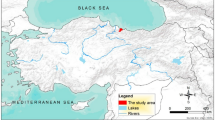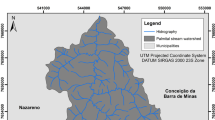Abstract
Soil conservation approaches and agroforestry systems can play an important role in controlling erosion from tropical hillside cropping systems. Experimental testing of their potential application domain and design, however, is costly and time consuming. We, therefore, tested the ability of the Water, Nutrient and Light Capture in Agroforestry Systems (WaNuLCAS) model. The specific objectives of the study were: (i) to evaluate the WaNuLCAS model for predicting water induced erosion under different soil conservation strategies, (ii) to use the model for a better understanding of various soil conservation measures in controlling erosion, and (iii) to assess the magnitude and dynamics of key processes influencing the efficiency of soil conservation measures. A 3-year-data set (2003–2005) from a field experiment from the Loei province in Northeast Thailand on the impact of soil conservation (Leucaena hedgerow, Jack bean relay cropping) under minimum tillage on runoff and soil loss was tested. Results indicated that WaNuLCAS was able to predict soil loss and runoff well at the test site; i.e. R 2 = 0.80 and 0.82, respectively. In the calibration procedure a sub data set was used, where adjusting crop development parameters was an important step for improving simulated soil loss (R 2 = 0.75) and runoff (R 2 = 0.89). Soil conservation measures such as Leucaena hedges were effective techniques to control runoff and soil loss. Implementing a dynamic soil structure module in combination with minimum tillage reduced runoff and soil loss via an increase in available macropores and hence drainage over time which improved simulation results. Relay cropping with Jack bean played an important role in the control treatment in reducing soil loss during the third year due to its additional soil cover and positive impact on soil fertility as suggested by the model. Hence, the WaNuLCAS model is a valuable tool to study and understand processes and to explore management options for improving tropical hillside cropping threatened by soil degradation.











Similar content being viewed by others
References
Agus F, Cassel DK, Garrity DP (1997) Soil-water and soil physical properties under contour hedgerow systems on sloping oxisols. Soil Tillage Res 40:185–199
Blanchart E, Albrecht A, Brown G, Decaens T, Duboisset A, Lavelle P, Mariani L, Roose E (2004) Effects of tropical endogeic earthworms on soil erosion. Agric Ecosyst Environ 104:303–315
Botterweg P, Leek R, Romstad E, Vatn A (1998) The EUROSEM-GRIDSEM modeling system for erosion analyses under different natural and economic conditions. Ecol Model 108:115–129
Durán Zuazo VH, Martίnez JRF, Pleguezuelo CRR, Martίnez Raya A, Rodrίguez BC (2006) Soil-erosion and runoff prevention by plant covers in a mountainous area (SE Spain): implications for sustainable agriculture. Environmentalist 26:309–319
Flanagan DC, Laflen JM (1997) The USDA Water Erosion Prediction Project (WEPP). Eurasian Soil Sci 30:524–530
Foster GR, Lane LJ, Nowlin JD, Laflen JM, Young RA (1980) A model to estimate sediment yield from field-sized areas: development of model. In: Knisel WG (ed) CREAMS: a field scale model for Chemicals, Runoff, and Erosion from Agricultural Management Systems. U.S. Department of Agriculture, Science and Education Administration, Conservation Report No. 26, pp 36–64
Graves A, Matthews R, Waldie K (2004) Low external input technologies for livelihood improvement in subsistence agriculture. Adv Agron 82:473–555
Hairiah K, Sulistyani H, Suprayogo D, Widianto, Purnomosidhi P, Widodo RH, Van Noordwijk M (2006) Litter layer residence time in forest and coffee agroforestry systems in Sumberjaya, West Lampung. For Ecol Manag 224:45–57
Hatfield JL (2006) Erosion: on-site and off-site impacts. In: Lal R (ed) Encyclopedia of soil science. USDA-ARS, Ames, pp 647–649
Imo M, Timmer VR (2000) Vector competition analysis of a Leucaena-maize alley cropping system in western Kenya. For Ecol Manag 126:255–268
Joshi L, Shrestha PK, Moss C, Sinclair FL, Van Noordwijk M, Cadisch G, Ong CK (2004a) Locally derived knowledge of soil fertility and its emerging role in integrated natural resource management. In: van Noordwijk M, Cadisch G, Ong CK (eds) Belowground interactions in tropical agroecosystems: concepts and models with multiple plant components. CABI, Wallingford, pp 17–40
Joshi L, Schalenbourg W, Johansson L, Khasanah N, Stefanus E, Fagerstrom MH, van Noordwijk M (2004b) Soil and water movement: combining local ecological knowledge with that of modellers when scaling up from plot to landscape level. In: Van Noordwijk M, Cadisch G, Ong CK (eds) Below-ground interactions in tropical agroecosystems: concepts and models with multiple plant components. CABI, Wallingford, pp 349–364
Kiepe P (1996) Cover and barrier effect of Cassia siamea hedgerows on soil conservation in semi-arid Kenya. Soil Technol 9:161–171
Kongkaew T (2000) Yield and nutrient budgets of hillside cropping systems with erosion control in Northern Thailand. Institute for Plant Production and Agroecology in the Tropics and Subtropics, University of Hohenheim, Stuttgart, p 112
Kozlowski TT (1982) Water supply and tree growth. Part. I. Water deficits (review article). For Abstr 43:57–95
Kuka K, Franko U, Rühlmann J (2007) Modelling the impact of pore space distribution on carbon turnover. Ecol Model 208:295–306
Lal R (1989) Agroforestry systems and soil surface management of a tropical Alfisol. II. Water runoff, soil erosion and nutrient loss. Agrofor Syst 8:97–111
Lal R (1998) Soil erosion impact on agronomic productivity and environment quality. Crit Rev Plant Sci 17:319–464
Lal R (2001) Soil degradation by erosion. Land Degrad Dev 12:519–539
Lal R (2007) Anthropogenic influences on world soils and implications to global food security. Adv Agron 93:69–93
Land Development Department (1998) Soil erosion in Thailand. Land Development Department, Bangkok, 39 pp
Lefroy RDB, Craswell ET (1998) Sustainable agriculture and natural resource management. In: Johnston AE et al (eds) Nutrient management for sustainable crop production in Asia. CAB International, New York
Leihner DE, Ruppenthal M, Hilger TH, Castillo JA (1996) Soil conservation and crop productivity of forage legume intercropping, contour grass barriers and contour ridging in cassava on Andean hillsides. Exp Agric 32:327–358
Loague K, Green RE (1991) Statistical and graphical methods for evaluating solute transport models: overview and application. J Contam Hydrol 7:51–73
Mati BM, Morgan RPC, Quinton JN (2006) Soil erosion modelling with EUROSEM at Embori and Mukogodo catchments, Kenya. Earth Surf Proc Land 31:579–588
Matthews R, Stephens W, Hess T, Middleton T, Graves A (2001) Applications of crop/soil simulation models in tropical agricultural systems. Adv Agron 76:31–124
Melville N, Morgan RPC (2001) The influence of grass density on effectiveness of contour grass strips for control of soil erosion on low angle slopes. Soil Use Manag 17:278–281
Misra RK, Rose CW (1996) Application and sensitivity analysis of process-based erosion model GUEST. Eur J Soil Sci 47:593–604
Morgan RPC (2005) Soil erosion and conservation. Blackwell Publishing, USA, 304 pp
Mugendi DN, Kanyi M, Wamicha W, Mugwe J (2003) The role of agroforestry trees in intercepting leached nitrogen in the agricultural systems of the Central Highlands of Kenya. East Afr Agric For J 69:69–73
Nguyen VD, Douglas I, McMorrow J, Lindley S, Dao KNTB, Tran TV, Le HT, Nguyen T (2008) Erosion and nutrient loss on sloping land under intense cultivation in southern Vietnam. Geogr Res 46:4–16
Paningbatan EP, Ciesiolka CA, Coughlan KJ, Rose CW (1995) Alley cropping for managing soil erosion of hilly lands in the Philippines. Soil Technol 8:193–204
Pansak W, Dercon G, Hilger T, Kongkaew T, Cadisch G (2007) 13C isotopic discrimination: a starting point for new insights in competition for nitrogen and water under contour hedgerow systems in tropical mountainous regions. Plant Soil 298:175–189
Pansak W, Hilger TH, Dercon G, Kongkaew T, Cadisch G (2008) Changes in the relationship between soil erosion and N loss pathways after establishing soil conservation systems in uplands of Northeast Thailand. Agric Ecosyst Environ 128:167–176
Parton WJ, Schimel DS, Cole CV, Ojima DS (1987) Analysis of factors controlling soil organic matter levels in Great Plains grasslands. Soil Sci Soc Am J 51:1173–1179
Radersma S, Lusiana B, Noordwijk MV (2005) Simulation of soil drying induced phosphorus deficiency and phosphorus mobilization as determinants of maize growth near tree lines on a Ferralsol. Field Crops Res 91:171–184
Renard KG, Foster GR, Weesies GA, Porter JP (1991) RUSLE: revised universal soil loss equation. J Soil Water Conserv 46:30–33
Ritsema C, Van Lynden G, Jetten V, de Jong S (2005) Degradation. In: Hillel D (ed) Encyclopedia of soils in the environment. Elsevier, Oxford, pp 370–377
Rose CW (1985) Developments in soil erosion and deposition models. Adv Soil Sci 2:1–63
Rose CW (1998) Research progress on soil erosion processes and a basis for soil conservation practises. In: Lal R (ed) Soil erosion research methods. Soil and Water Conservation Society, Ankeny, pp 119–140
Rose CW, Freebairn DM (1985) A new mathematical model of soil erosion and deposition processes with applications to field data. In: Swaify SA, Moldenhauer WC, Lo A (eds) Soil erosion and conservation. Soil Conservation Society of America, Ankeny, pp 549–557
Rowe EC, Van Noordwijk M, Suprayogo D, Cadisch G (2005) Nitrogen use efficiency of monoculture and hedgerow intercropping in the humid tropics. Plant Soil 268:61–74
Singh RP, Ong CK, Saharan N (1989) Above and below ground interactions in alley-cropping in semi-arid India. Agrofor Syst 9:259–274
Suprayogo D, Van Noordwijk M, Hairiah K, Cadisch G (2002) The inherent ‘safety-net’ of an Acrisol: measuring and modelling retarded leaching of mineral nitrogen. Eur J Soil Sci 53:185–194
Toy TJ, Foster GR, Renard KG (2002) Soil erosion: processes, prediction, measurement and control. Wiley, New York, 338 pp
van Genuchten MT (1980) A closed-form equation for predicting the hydraulic conductivity of unsaturated soils. Soil Sci Soc Am J 44:892–898
Van Noordwijk M, Cadisch G (2002) Access and excess problems in plant nutrition. Plant Soil 247:25–40
Van Noordwijk M, Lusiana B (1998) WaNulCAS, a model of water, nutrient and light capture in agroforestry systems. Agrofor Syst 43:217–242
Van Noordwijk M, Lusiana B, Khahasanah N (2004) WaNuLCAS version 3.1: background on a model of water nutrient and light capture in agroforestry system. International Centre for Research in Agroforestry (ICRAF), Bogor
Van Rompaey AJJ, Govers G, Puttemans C (2002) Modelling land use changes and their impacts on soil erosion and sediment supply to rivers. Earth Surf Proc Land 27:481–494
Walker AP, Mutuo PK, Van Noordwijk M, Albrecht A, Cadisch G (2007) Modelling of planted legume fallows in Western Kenya using WaNuLCAS. (I) Model calibration and validation. Agrofor Syst 70:197–209
Walker AP, van Noordwijk M, Cadisch G (2008) Modelling of planted legume fallows in Western Kenya. (II) Productivity and sustainability of simulated management strategies. Agrofor Syst 74:143–154
Wischmeier WH, Smith DD (1958) Rainfall energy and its relationship to soil loss. Trans Am Geophys Union 39:285–291
Wösten JHM, Lilly A, Nemes A, Le Bas C (1998) Using existing soil data to derive hydraulic parameters for simulation models in environmental studies and in land use planning Winand Staring Centre, Wageningen. Report No. 156, 106 pp
Yemoah C, Agboola AA, Wilson GF (1986) Nutrient contribution and maize performance in alley cropping systems. Agrofor Syst 4:247–254
Young A (1997) Agroforestry for soil management, 2nd edn. CAB International, Wallingford, p 320
Acknowledgements
This research was funded by the National Centre for Genetic Engineering and Biotechnology (BIOTEC), Thailand, the German Academic Exchange Service (DAAD), and the Special Research Programme (SFB 564) from DFG (Deutsche Forschungsgemeinschaft), Germany.
Author information
Authors and Affiliations
Corresponding author
Rights and permissions
About this article
Cite this article
Pansak, W., Hilger, T., Lusiana, B. et al. Assessing soil conservation strategies for upland cropping in Northeast Thailand with the WaNuLCAS model. Agroforest Syst 79, 123–144 (2010). https://doi.org/10.1007/s10457-010-9290-2
Received:
Accepted:
Published:
Issue Date:
DOI: https://doi.org/10.1007/s10457-010-9290-2




